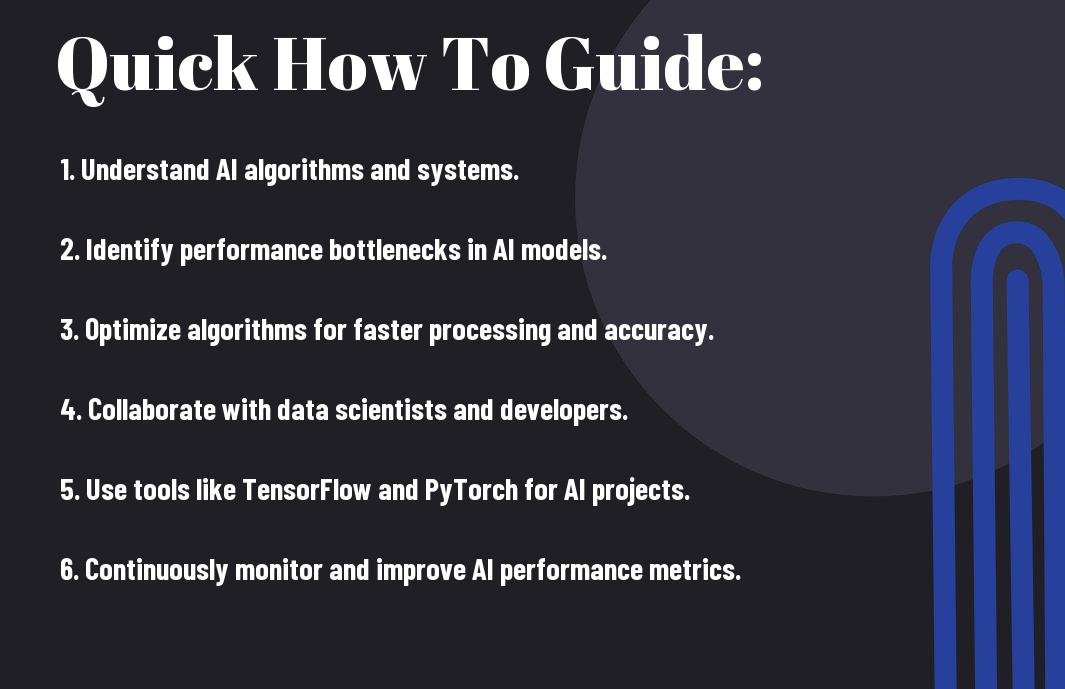Overseeing the performance of artificial intelligence (AI) systems is crucial for ensuring optimal efficiency and accuracy. A prompt engineer plays a pivotal role in fine-tuning AI models by crafting targeted prompts that guide the system to generate the desired outputs. This strategic approach not only enhances the AI’s performance but also reduces the risk of biased results or incorrect predictions. Understanding the significance of a prompt engineer in maximizing AI efficiency is necessary for organizations looking to leverage the full potential of their technological investments.
Key Takeaways:
- Understanding the Machine Learning Algorithm: A prompt engineer plays a crucial role in understanding the intricacies of the machine learning algorithm being used and can provide insights to maximize its efficiency.
- Optimizing Data Inputs: By carefully crafting prompts and input data, a prompt engineer can optimize the AI model’s performance and accuracy, leading to more effective results.
- Monitoring and Fine-Tuning AI Models: Continuously monitoring the AI model’s performance and fine-tuning it based on the prompt engineer’s feedback can lead to significant improvements in efficiency and productivity.

How to Identify Key Factors for AI Efficiency
If you want to maximize artificial intelligence efficiency, it is crucial to identify key factors that contribute to its overall performance. By focusing on specific elements, you can streamline the development process and ensure that the AI system delivers optimal results. Here are some chatGPT prompt samples that can help you identify these key factors:
- "Prompt: List out the main requirements for enhancing AI efficiency."
- "Prompt: Identify the key metrics to measure AI system performance."
- "Prompt: Describe the impact of data quality on AI efficiency."
- "Prompt: Explain how to optimize AI algorithms for maximum efficiency."
- Understanding system requirements: Analyzing the specific needs and goals of the AI system is crucial for maximizing efficiency.
- Optimizing data quality: Ensuring that the data used for training and testing the AI system is accurate and relevant is crucial for its performance.
- Improving algorithm efficiency: Optimizing the algorithms used by the AI system can significantly impact its overall efficiency.
Knowing these key factors and addressing them effectively will lead to a more efficient artificial intelligence system.
Analyzing System Requirements
If you are looking to enhance AI efficiency, analyzing system requirements is the first step. By clearly defining the goals and objectives of the AI system, you can better understand what is needed to optimize its performance. Here are some chatGPT prompt samples to help you analyze system requirements:
- "Prompt: Define the specific goals of the AI system."
- "Prompt: List out the key features required for the AI system to function efficiently."
- "Prompt: Describe the target audience for the AI system and their needs."
- "Prompt: Explain how to prioritize system requirements for maximum efficiency."
Assessing Data Quality and Quantity
Now, assessing the quality and quantity of data is crucial for optimizing AI efficiency. High-quality data ensures that the AI system learns effectively and produces accurate results. By assessing the data available and making necessary improvements, you can enhance the performance of the AI system. Here are some chatGPT prompt samples related to assessing data quality and quantity:
- "Prompt: Evaluate the sources of data for the AI system and their reliability."
- "Prompt: Define the criteria for data quality and how to measure it accurately."
- "Prompt: Discuss the significance of data quantity in training AI models."
- "Prompt: Explain how to augment data sets to improve AI performance."
Now, it’s imperative to consider the quality and quantity of data available for the AI system. High-quality data ensures accurate results and effective learning, ultimately optimizing the system’s efficiency.
Requirements: Ensuring that all system requirements are met is crucial for maximizing AI efficiency. Analyzing key factors such as system requirements, data quality, and algorithm optimization is crucial for achieving optimal performance and results.

How to Design Effective Prompts for AI
Not all prompts are created equal when it comes to maximizing AI efficiency. Crafting effective prompts plays a crucial role in eliciting accurate and relevant responses from artificial intelligence models. To help you design prompts that yield optimal results, here are some sample prompts tailored for various scenarios:
1. Summarize the key points discussed in the article.
2. Generate a fictional dialogue between two historical figures.
3. Describe the process of photosynthesis in simple terms.
4. Create a short story set in a post-apocalyptic world.
5. Provide tips for improving productivity in the workplace.
Tips for Crafting Clear and Concise Prompts
Crafting clear and concise prompts is necessary to ensure that AI models understand the task at hand accurately. Ambiguity or verbosity can lead to misinterpretations or irrelevant outputs. Here are some sample prompts to guide you in crafting clear and concise instructions:
1. Define the concept of artificial intelligence in two sentences.
2. Compare and contrast the features of iOS and Android operating systems.
3. List the advantages and disadvantages of renewable energy sources.
4. Summarize the key takeaways from the meeting in bullet points.
5. Provide a step-by-step guide to baking a chocolate cake.
- Use clear and succinct language to convey your prompts effectively.
- Avoid jargon or ambiguous terms that could confuse the AI model.
- Structure prompts in a logical order to facilitate understanding.
- Assume that the AI model has no prior knowledge beyond the provided prompt.
Incorporating Context and Flexibility into Prompts
Some of the most powerful prompts are those that can adapt to different contexts and offer flexibility in responses. By incorporating relevant context and allowing room for creativity, you can unlock the full potential of AI models. Here are some prompts designed to leverage context and flexibility:
1. What would be the implications of discovering extraterrestrial life?
2. How would you explain the concept of gravity to a young child?
3. Describe a typical day in the life of a superhero.
4. Predict the future advancements in artificial intelligence technology.
5. Create a marketing pitch for a revolutionary new product.
Some prompts are specifically crafted to provide additional context or require the AI model to think beyond conventional boundaries. By allowing flexibility in responses, AI can generate more innovative and diverse outputs, showcasing the true capabilities of artificial intelligence technology.
1. What ethical considerations should be taken into account when developing autonomous vehicles?
2. Imagine a world where time travel is possible – how would this impact society?
3. Describe a scenario where humans coexist with intelligent alien species.
4. Predict the effects of climate change on global ecosystems in the next century.
5. Provide a detailed analysis of the implications of quantum computing on cybersecurity.
Crafting prompts that encompass context and flexibility is necessary to push the boundaries of AI capabilities and stimulate innovative responses. By providing rich contextual information and encouraging open-ended exploration, AI models can generate more insightful and imaginative outputs that go beyond simple pattern recognition.
When designing prompts for AI systems, it is crucial to strike a balance between specificity and open-endedness, allowing for a diverse range of responses while maintaining relevance to the task at hand. Incorporating context and flexibility into prompts not only challenges AI models to think critically but also enhances their ability to adapt and generate creative solutions to complex problems.
In short, mastering the art of designing effective prompts is key to maximizing artificial intelligence efficiency and unlocking the full potential of AI technologies.
How to Optimize AI Responses
For this chapter, we will investigate into the strategies involved in optimizing AI responses to maximize efficiency and accuracy. This involves refining prompt parameters and continuously monitoring and iterating on responses to ensure the AI performs at its best.
Refining Prompt Parameters
1. Provide examples of both good and bad prompts.
2. Adjust the length and complexity of prompts.
3. Experiment with different prompt formats.
Assuming you want to fine-tune your AI model’s responses, refining prompt parameters is crucial. By carefully crafting the input prompts, you can guide the AI to generate more accurate and relevant outputs tailored to your specific needs.
Monitoring and Iterating on Responses
1. Analyze the consistency and quality of AI responses.
2. Track the performance metrics of the AI model.
3. Collect feedback from users to identify areas for improvement.
Assuming you want to ensure your AI remains efficient over time, monitoring and iterating on responses are key. By consistently evaluating the AI’s outputs, you can identify patterns, address any issues, and continuously enhance the system’s performance.
With monitoring and iterating on responses, it is vital to stay vigilant and proactive in optimizing the AI’s performance. Regularly reviewing the generated outputs and collecting feedback from users can provide valuable insights for refining the AI model further, leading to more accurate and efficient responses. It is important to identify any potential biases or errors early on and take corrective actions to maintain the AI’s quality and reliability.
How to Collaborate with AI Development Teams
Despite the sophistication of Artificial Intelligence (AI) systems, successful collaboration with AI development teams is imperative for maximizing efficiency. Here are some key strategies to foster effective collaboration:
1. Generate diverse and relevant training data.
2. Clearly define project goals and requirements.
3. Regularly communicate and provide feedback to improve the AI model.
4. Ensure transparency and ethics in AI development.
5. Collaborate on troubleshooting and solution implementation.
6. Stay updated on the latest AI technologies and best practices.
Communication Strategies with Stakeholders
Assuming a clear line of communication with stakeholders is crucial for the successful development and implementation of AI projects. Whether it’s discussing project objectives, sharing progress updates, or addressing concerns, effective communication can ensure alignment and buy-in from all involved parties.
1. Discuss objectives and expectations with stakeholders.
2. Provide regular updates on project milestones.
3. Address any concerns or questions promptly.
4. Seek feedback and input from stakeholders for continuous improvement.
Integrating Feedback for Continuous Improvement
Improvement in AI systems is an ongoing process that heavily relies on feedback for refinement. By integrating feedback loops into the development cycle, teams can identify areas of improvement, address issues, and enhance the overall performance of AI models.
1. Collect feedback from end-users and stakeholders.
2. Analyze feedback to identify trends and patterns.
3. Implement changes based on feedback for optimization.
4. Regularly evaluate performance and iterate on the model.
Another crucial aspect of integrating feedback for continuous improvement is the ability to adapt to evolving needs and challenges. By actively seeking and incorporating feedback, AI development teams can ensure that their systems remain relevant, efficient, and effective in addressing various real-world applications.
Final Words
Drawing together the crucial components of prompt engineering and its significant impact on maximizing artificial intelligence efficiency, it becomes apparent that prompt engineers play a vital role in shaping the performance of AI systems. By skillfully crafting prompts to guide AI models, prompt engineers can enhance accuracy, speed up training processes, and improve overall outcomes. To research deeper into the art and science of prompt engineering and its profound implications on AI technology, explore the insightful article The Art and Science of Prompt Engineering: Maximizing AI … for a comprehensive understanding of this critical field.
FAQ
Q: What is the role of a prompt engineer in maximizing artificial intelligence efficiency?
A: A prompt engineer plays a crucial role in maximizing artificial intelligence efficiency by designing and fine-tuning prompts that guide the AI model to generate desired outputs. They are responsible for creating prompts that help the AI system understand the context of the task and produce accurate results.
Q: What skills are important for a prompt engineer in the field of artificial intelligence?
A: Essential skills for a prompt engineer in the field of artificial intelligence include a deep understanding of natural language processing, machine learning algorithms, and the ability to analyze and interpret data. Additionally, strong programming skills in languages such as Python and experience with AI frameworks like TensorFlow or PyTorch are also crucial.
Q: How can a prompt engineer contribute to the continuous improvement of AI models?
A: A prompt engineer can contribute to the continuous improvement of AI models by conducting thorough analysis of model performance, identifying areas for enhancement, and refining prompts to address any shortcomings. By iteratively optimizing prompts and evaluating model outputs, prompt engineers can help AI systems learn and adapt to produce more accurate and efficient results over time.







